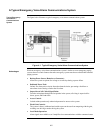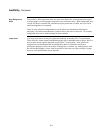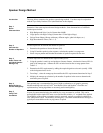
5-2
For emergency messages to be heard, NFPA 72 suggests that the sound level of the emergency
evacuation tone to be measured at 5-feet. This is the average “ear level” of someone standing.
The messages must be 15 dBA above normal ambient sound or 5 dBA above sounds lasting longer
than 60 seconds. When performing a site investigation for speaker placement and power settings,
a survey of the area with a dBA reading sound level meter is used to determine the proper sound
level required. In sleeping areas, the audibility requirements are the same except measurements
are taken at the normal ear level for someone sleeping (at pillow level).
From NFPA 72, 2002 Edition:
“7.4.2.1* To ensure that audible public mode signals are clearly heard, unless otherwise
permitted by 7.4.2.2 through 7.4.2.5, they shall have a sound level at least 15 dB above the
average ambient sound level or 5 dB above the maximum sound level having a duration of at least
60 seconds, whichever is greater, measured 1.5 m (5 ft) above the floor in the occupiable area,
using the A-weighted scale (dBA).”
When measuring tones, the SPL must be maintained in all parts of the building, however several
cases receive special consideration. Elevators (7.4.2.2) and restrooms (7.4.2.5) are cited.
When determining the level of background noise, it is not necessary to take into consideration
sources such as construction equipment or other sources that would not normally be present.
It is however required to take into consideration normal noise sources that last longer than
60 seconds; vacuum cleaners are cited as an example in Annex A.7.4.1.3.
When designing for new construction where a survey is not possible, Annex A of NFPA 72
provides guidance of the anticipated ambient sound level.
From NFPA 72, 2002 Edition:
A.7.4.2 The typical average ambient sound level for the occupancies specified in Table A.7.4.2 are
intended only for design guidance purposes. The typical average ambient sound levels specified
should not be used in lieu of actual sound level measurements.
Table A.7.4.2 Average Ambient Sound Level According to Location
Location Average Ambient Sound Level (dBA)
Business occupancies 55
Educational occupancies 45
Industrial occupancies 80
Institutional occupancies 50
Mercantile occupancies 40
Mechanical rooms 85
Piers and water-surrounded structures 40
Places of assembly 55
Residential occupancies 35
Storage occupancies 30
Thoroughfares, high density urban 70
Thoroughfares, medium density urban 55
Thoroughfares, rural and suburban 40
Tower occupancies 35
Underground structures and windowless buildings 40
Vehicles and vessels 50
Note: Audibility must be verified at the time of system commissioning and periodically verified
in accordance with the requirements stated in the “Inspection, Testing, and Maintenance”
chapter of NFPA 72.
Continued on next page
Audibility
Tones and SPL


















